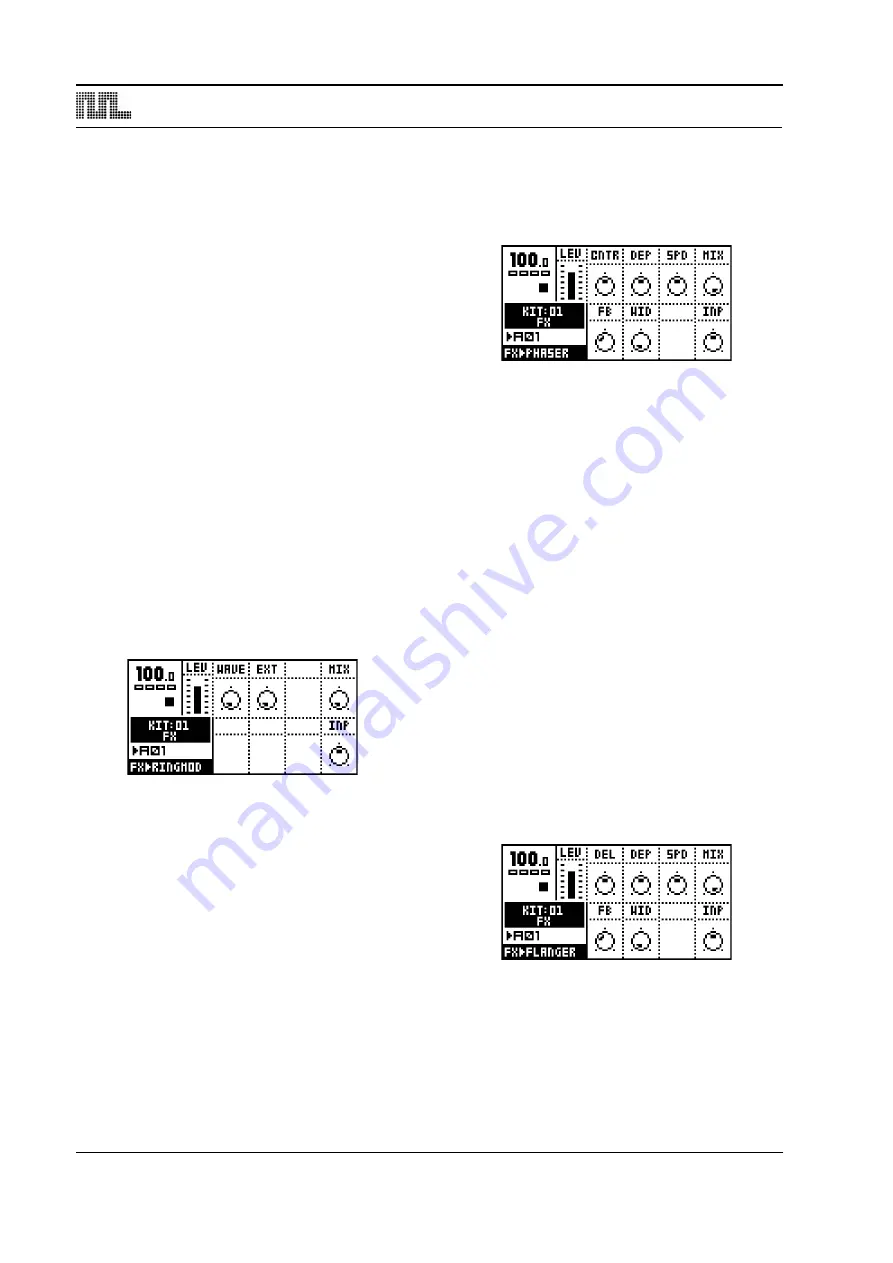
A-14
Appendix A: MACHINE REFERENCE
DYNAMIX TUTORIAL
This is just a general overview of one way
you can approach the Dynamix processor.
No exact parameter values can be given as
they depend on the signal processed.
1.
Turn up
RAT
. Setting the compression
ratio to zero (1:1) means that the signal
will pass straight through. Setting
RAT
to
its full value 127 (1:255) makes it a so
called
limiter
.
2.
Turn
THRS
down. The peaks of the input
signal should now be reduced.
3.
Increase the
RMS
parameter if the incom-
ing waveform is low in overall volume but
have high signal peaks.
4.
Adjust
ATK
and
REL
to match the input
signal. Too slow attack will cause over-
shoots (pumping) in the out signal.
5.
Increase
GAIN
to compensate for loss of
volume.
RING MODULATOR
The ring modulator of the Monomachine
allows you to ringmodulate an incoming sig-
nal with an internal carrier oscillator.
WAVE
(wave) selects the waveform of the
carrier oscillator. When WAVE is set to zero
the oscillator outputs a sine wave, when set
to 127 it outputs a triangle wave.
EXT
(external signal) sets the amount of the
incoming signal that should be ringmodu-
lated with the waveform selected by the
WAVE
parameter.
MIX
(signal mix) adjusts the output between
the original “dry” signal and the “wet” signal.
INP
(input signal amplification) adjusts the
signal input.
PHASER
The Monomachine phaser lets you apply
sweeping effects to your sounds. It can also
be used to make sounds appear wider.
CNTR
(center) selects the center phase of
the phase modulation.
DEP
(depth) sets the depth of the phase
modulation.
SPD
(speed) adjusts the speed of the phase
depth modulation.
MIX
(signal mix) adjusts the output between
the original “dry” signal and the “wet” signal.
FB
(feedback)
controls the feedback of the
original signal.
WID
(width)
controls the stereo width of the
affected signal.
INP
(input signal amplification) adjusts the
signal input.
FLANGER
The flanger is a bit similar to the phaser. The
main difference is that the frequency notches
are evenly spread across the freqency
range.
DEL
(delay) controls the amount of delay of
the flanged signal.
DEP
(depth) controls the depth of the
flanger.
SPD
(speed) adjusts the speed of the
flanger.
Summary of Contents for SFX-6
Page 1: ......
Page 8: ...6 of 6 ...
Page 24: ...MONOMACHINE OVERVIEW 16 FIGURE 1 Monomachine sound synthesis overview ...
Page 68: ...THE PATTERN SEQUENCER 60 FIGURE 7 Trig track illustrations ...
Page 135: ...Appendix A MACHINE REFERENCE A 11 ...
Page 140: ...A 16 Appendix A MACHINE REFERENCE ...
Page 152: ...C 6 Appendix C SYSEX REFERENCE ...
Page 156: ...4 INDEX ...
Page 157: ......
Page 158: ...ElektronMusicMachinesAB ErikDahlbergsgatan3 41126Gothenburg Sweden www elektron se ...




































